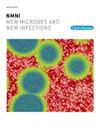Mixta calida不仅是一种环境细菌,还是一种潜在的机会性威胁:伴有皮肤坏死的骨膜炎病例报告及文献综述
IF 2.9
Q2 INFECTIOUS DISEASES
引用次数: 0
摘要
背景卡氏混合菌(Pantoea calida)是一种环境细菌,很少与人类病症相关。罕见病例报告中提到了败血症、脑膜炎和植入式除颤器感染。病例介绍 一位 67 岁的女性患者因摔倒导致右侧胫骨平台粉碎性骨折而被转入急诊室,她患有多种并发症,曾使用过外固定器。在取出固定器、骨合成失败和放置新固定器后,出现了皮肤坏死,于是进行了螺旋桨式大腿前内侧远端穿孔器皮瓣手术。6 周后,她出现皮瓣坏死和骨炎。骨活检结果显示,卡氏疟原虫呈阳性。患者接受了膝上截肢手术,但 6 周后伤口开裂,再次出现纯卡氏疟原虫阳性。本病例是首次报道的卡氏痢疾杆菌引起的骨膜炎和皮肤坏死。本文章由计算机程序翻译,如有差异,请以英文原文为准。
Mixta calida, not only an environmental bacterium, but a potential opportunistic threat: Case report of an osteitis with skin necrosis and mini review of the literature
Background
Mixta calida, previously known as Pantoea calida, is an environmental bacterium rarely associated with human pathologies. Rare case reports mention sepsis, meningitis and implantable defibrillator infection.
Case presentation
A 67-year-old female with multiple comorbidities was referred to the emergency room for a comminuted fracture of both right tibial plateaus secondary to a fall and for which she benefited from an external fixator. After removal of the fixator, failure of osteosynthesis and placement of a new fixator, a skin necrosis appeared and a propeller distal anteromedial thigh perforator flap was performed. After 6 weeks, she presented a necrosis of the flap and an osteitis. The bone biopsy was positive with pure M. calida. The patient underwent an above-knee amputation, but 6 weeks later the wound was dehiscent and again positive with pure M. calida.
Conclusions
Serious infections due to M. calida are uncommon but can occur in immunocompromised patients. This case illustrates the first reported osteitis and skin necrosis due to M. calida.
求助全文
通过发布文献求助,成功后即可免费获取论文全文。
去求助
来源期刊

New Microbes and New Infections
Medicine-Infectious Diseases
CiteScore
10.00
自引率
2.50%
发文量
91
审稿时长
114 days
 求助内容:
求助内容: 应助结果提醒方式:
应助结果提醒方式:


